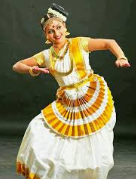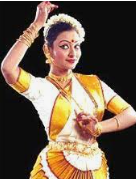MOHINIYATTAM (THE AIR)
MOHINIYATTAM DANCE
Mohiniyattam means 'mohini', the celestial enchantress of the hindu mythology, is the classical solo dance form of kerala. Mohiniyattam represents the element of Air.
According to a puranic story, Lord vishnu took on the guise of a 'mohini' to seduce the asuras, both in connection with churning of the ocean and episode of the slaying of bhasmasur.
Mohiniyattam is a lasya predomonates. Mohiniyattam can be found in the texts Vyavaharamala written in 1709 by Mazhamagalam narayanan namputiri and in ghoshayatra, written later by great poet kunjan namiar.
DANCE SPECIALITIES- It is mostly a solo performance by girls with circular movements, subtle expressions, and delicate footsteps.
Movements in mohiniyattam have been borrowed from nangiar koothu and female falk dance the tiruvatirakali and kaikottikoli. This dance has elements of bharatnatyam( grace and elegance) and kathakali (vigour) but is more erotic, delicate and lyrical.
The dancers were called by different names during different periods of time. They were called as- Tainangai or nangachi (one with beautiful hand), dasi (servant), tevitichi or deva-adi-achi (the one who served at the feet of the lord), koothachi (who performed koothu or dance).
Their dancers were known as 'Nangai, Natakam, Dasiyattam, Tevitichiyattam,etc.
The nangiars, who are the women folk of nambiar community, still follow a strict code of dance, performed in a small performing space, within the temple precincts, as practised in the olden times.
Mohiniyattam is characterized by graceful swaying body movements with no abrupt jerks or sudden leaps. It belongs to the lasya style which is feminine tender and graceful.
The movements are emphasized by the glides and the up and down movements on toes, like the waves of the sea and the swaying of the coconut palm trees and the paddy firlds.
The hand gestures, 24 in number, are mainly adopted from hastalakshana deepika, A text followed by kathakali. Few are also borrowed from natyashastra.
Abhinaya darpan and balarambharatam.
The gestures and facial expressions are closer to the natural(gramya) and the realistic (lokadharmi) than to the dramatic or rigidly conventional(natyadharmi).
COSTUME AND MAKE-UP - Realistic make-up and simple dressing (in kasavu saree of kerala) are used.
MUSIC - Carnatic music used in mohiniyattam. The lyrics are in manipravalam a medieval south indian. Language combining sanskrit, tamil, and malayalam.
PATRONS- This dance form of kerala was structured into the present day classical format by the travanacore kings, Maharaja kartika tirunal and his successor Maharaja swatu tirunal (18th-19th) century c.e.









Comments
Post a Comment